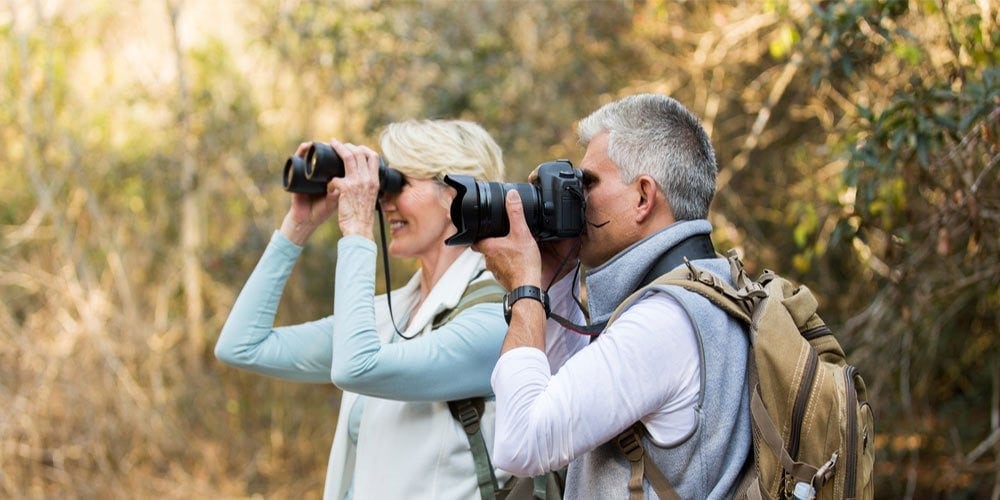Contents
Birdwatching is a fun and easy hobby to get into. It doesn’t take a lot of money to get started and you can do it from anywhere, including your backyard! In fact, according to the national survey completed in 2016 by the U.S. Fish & Wildlife Service, more than 45 million people enjoy watching birds from their homes or away from home. Birding and other wildlife watchers contribute up to $80 billion of the US economy.
There are many different ways you can enjoy birding and this article will provide you with the steps you need to take. Everything from the basics to get started with birdwatching to planing trips for elaborate adventures!
Start Birdwatching At Home In Your Own Backyard
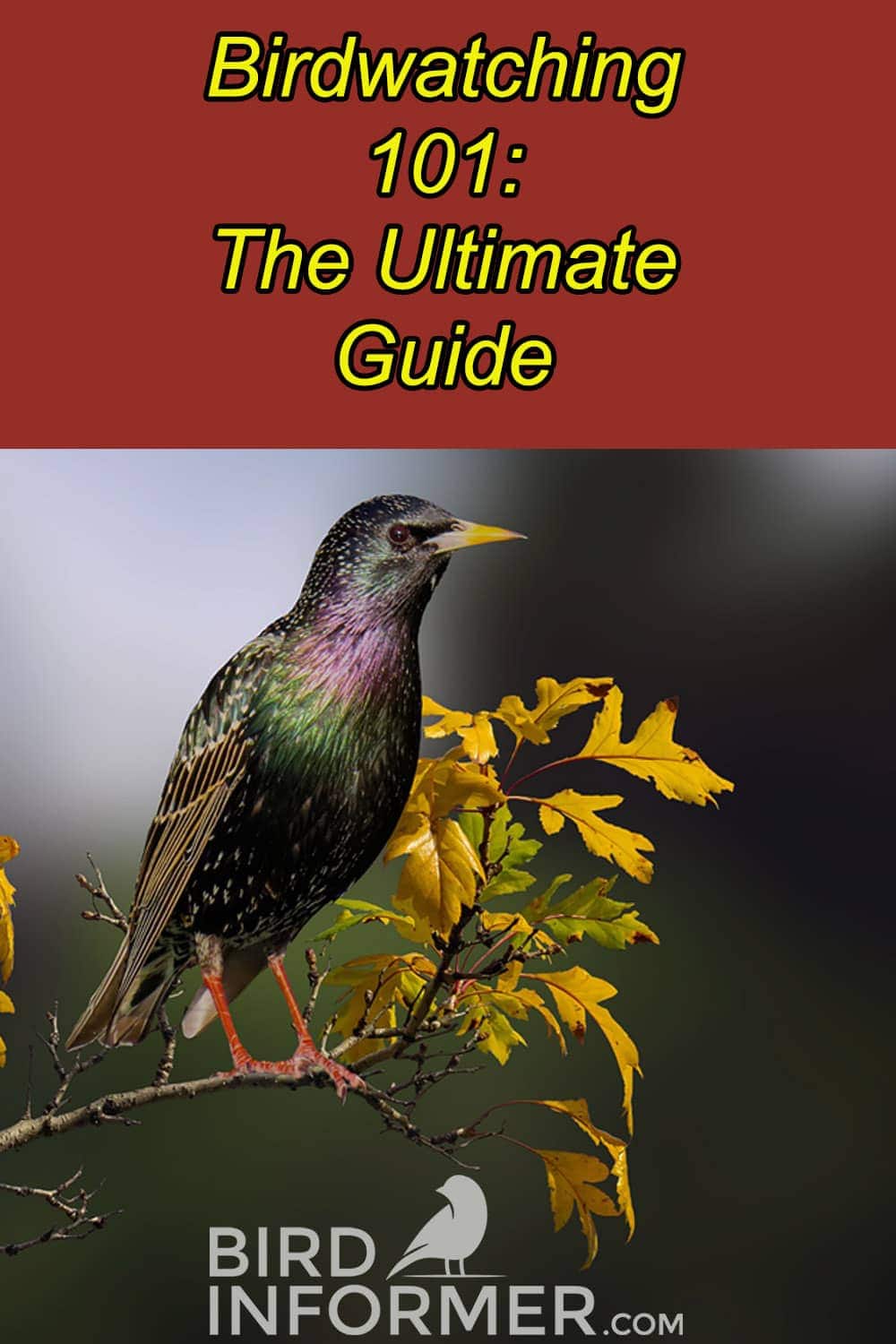
It is extremely easy to start creating your backyard bird retreat. Here, I will go over some basic methods to start attracting birds to your backyard. Everything from bird feeders to vegetation and habitat.
Trees, Shrubs, and Plants
There is no doubt that what attracts birds to a place is the plants and trees that surround it. If you have a big enough space where you can attract some of them to create nests or visit your backyard, then you will need plants, trees, and shrubs to get them to stay where you can observe them.
A developer named Jeff Radzak made a report entitled Domestic and Tropical Plants in Aviaries. In this report, he studies two groups of birds. One of which had a planted environment while the other group had a bare flight. He found that those birds that lived in the planted environment thrived better than the other group.
Not all plants however are safe for birds. You can design your backyard aviary, however you want, by using these safe plants:
- Bougainvillea Bougainvillea
- Mulberry Tree Morus species
- Flowering Dogwood Cornus florida
- Crabapples Malus species
- White Oak Quercus alba
- Eastern Red Cedar Juniperus virginiana
- Virginia Creeper Parthenocissus quinquefolia
- Sunflowers Helianthus spp.
- Milkweed Asclepias spp.
- Cardinal Flower Lobelia cardinalis
Bird Feeders
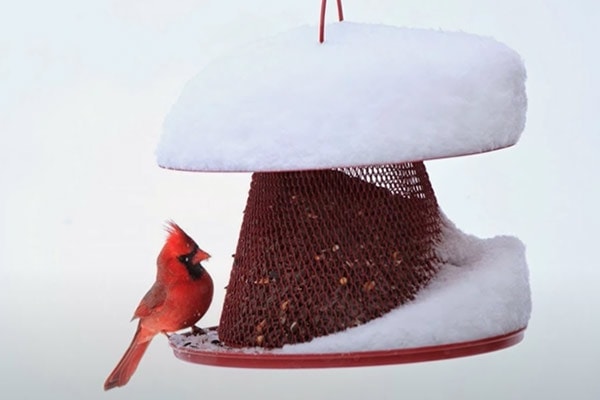
But of course, plants aren’t the only ones that attract birds to an aviary. Bird feeders would also be a wonderful and beneficial addition to your backyard aviary. You have to be strategic in where you place it, what type of bird feed that you use (Hummingbirds, Woodpeckers, Chickadees, Bluebirds, Blue Jays, Finches, Wild Birds, Song Birds, Orioles, Cardinals, Yellow Finches, etc.), and how big the bird feeder should be.
Here are some tips on how you can make your bird feeders advantageous for you aviary:
- Make it visible to the birds. You want them to see the feeder and allow them t also see the bird feed inside so they know that they can perch and eat there
- Create appropriate feeding ports for seed types and desired bird species
- Make it suit to the climate to avoid the seeds from getting wt with rain or ice during winter
- Make it as big as you can. Having multiple perches or platforms to accommodate many birds comfortably will make them want to go there more
- Always keep an eye on the feeder. Make sure that you have enough seeds to feed the birds visiting your aviary
- Make it resistant to pests with the use of built-in baffles or no-chew construction
- Always keep it clean. Get a feeder that is easy to maintain and easy to clean
There are many types of feeders available. You can even build one yourself if you are that crafty. No matter what design or shape of feeder you have, it will take some time for the birds to get accustomed to it. Patience is the key.
Bird Food
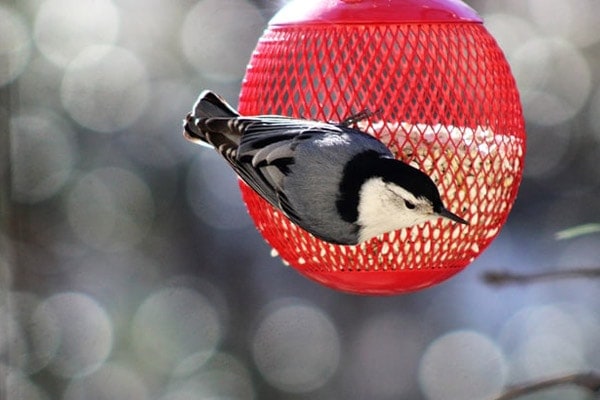
Now that you’ve got your feeder, it’s time to talk about what you have to fill those feeders with to attract certain types of birds. Many types of food can attract different types of bird species. Based also on your feeder, you might need a specific type of bird food.
Here are the types and kinds of bird food to attract the specific bird species you want:
- Sunflower – Click here to buy on Amazon >>
- There are two types of sunflower seeds, Black oil, and Striped. The black oil seed or oilers have very thin shells and can be easily cracked by any seed-eating bird. The kernels inside are very valuable for winter birds because of their high-fat content.
- The striped sunflower seeds, on the other hand, are harder to crack because of its thicker shells. So if you want to see more variety in your aviary, then better to change up the sunflower seeds once in a while.
- Among the favorites list of squirrels so you better watch out for them stealing your bird food.
- Safflower seeds – Click here to buy on Amazon >>
- Like the striped sunflower seeds, the Safflower is harder to open. It is the favorite among cardinals, grosbeaks, chickadees, doves, and native sparrows.
- They are not a favorite among house sparrows and European starlings.
- Best put in tray feeders or hopper feeders cardinals and grosbeaks.
- Nyjer seeds – Click here to buy on Amazon >>
- Absolute favorite food for Finches, such as the American Goldfinch, House Finch, Purple Finch, Pine Siskin, and other small songbirds.
- Nyjer seeds are a tiny delicacy and are used in finch feeders which have smaller holes and tiny perches, perfect for the Finches but discouraging to larger birds.
- White millet- Click here to buy on Amazon >>
- White Millet is inexpensive and nutritious tiny grains that offer more seed value than most larger seed varieties. They are a favorite among ground feeding birds like quails, native American sparrows, doves, towhees, juncos, and cardinals.
- Having this on low-suet feeders with excellent drainage would be most appropriate instead of just throwing them in them on the ground.
- Peanuts – Click here to buy on Amazon >>
- Peanuts are rich in protein and fats that are valuable for all birds, all year round. They are very popular for birds like jays, crows, chickadees, titmice, woodpeckers, and many other species.
- However, squirrels, bears, raccoons, and other animals also like peanuts very much.
- Canary seed – Click here to buy on Amazon >>
- Not a very popular choice for some birds but doves, finches, quails, and juncos like them very much. Although if you are not getting these types of birds, they just might spoil in your feeders and are not worth putting them there.
- Nectar – Click here for a simple recipe >>
- These are fuel for hummingbirds. This is a very simple recipe that you can easily make at home. Combine one part sugar to four parts sugar and mix until all sugar has dissolved.
- DO NOT add red dye!
- This can last at least two weeks in your refrigerator so make sure to not leave their feeders empty.
- Cracked Corn – Click here to buy on Amazon >>
- The type of corn that you use for feeding should be for bird feeding. Popcorn is often hazardous for birds and the corn for planting usually contains red dye and fungicides that are dangerous when consumed by birds and humans.
- Also always remember to keep corn dry as they are at risk of contamination from dangerous aflatoxins.
- Mealworms – Click here to buy on Amazon >>
- If you want some bluebirds in your yard, then mealworms are what you need to attract them. They are the prime choice to attract insect-eating birds. They are very easy to keep and store.
- Window feeders are the best to use for mealworms.
Here are some tips with bird food and feeders to keep the birds returning to your aviary:
- Don’t use cheap bird seeds
- Processed bread products are like junk food
- Offer natural food through planting fruit-bearing trees and bushes
- Leave bird food out for the winter birds
- Protect bird feeders from wild animals
Birdhouses and Nesting Boxes
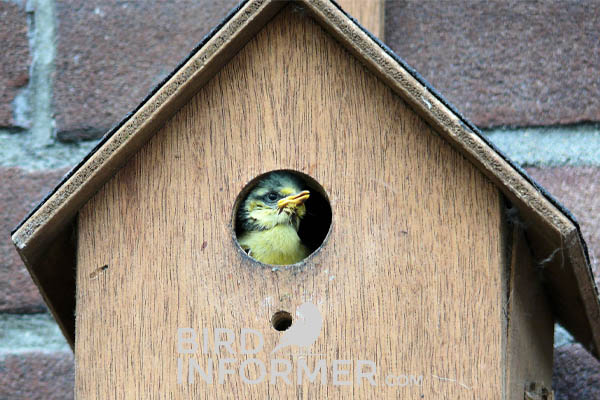
Birdhouses and nesting boxes are the same. The more proper term being the latter. As birds usually use these “birdhouses” for nesting. Something that I picked up while trying to make my nest box.
When building one of these nest boxes you have to make sure that it will be suitable for the birds to properly nest in one of them. Here are a few tips on how to make your birdhouse into a nest box:
- Hang your nest box or birdhouse where the young birds will not fry in the sun. Always keep them in the shade to avoid harming them with the sun.
- Make sure to clean these houses every year to make sure that it is ready for the next batch of nesters.
- Allow air to circulate by having an open area under the roof and have some drainage system for the water to come out.
- If birds don’t nest in your box for a couple of years, try to move it to a new location.
Nesting Shelf
A nesting shelf is for birds that prefer to build nests in a structure that is not fully enclosed. Certain species of birds are “open-nester” birds and prefer nesting in structures that are protected, yet open. For example, Cardinals are open-nesters and below is a great nesting shelf to use for open-nesting birds:
- EASY INSTALLATION: This roost is very easy to hang with pre-drilled mounting holes
- ENVIRONMENTAL: Made of clear cedar and eco-friendly recycled poly lumber. Recycled poly lumber is guaranteed not to crack, split, or fade
- EASY TO CLEAN: Open design and recycled poly lumber allows for easy cleaning
- MADE ENTIRELY BY HAND: Hand-made at our location at JCs Wildlife using Cedar Wood and Poly Lumber
- DIMENSIONS: 8" W X 11.75" H X 8.5" D
Bird Fountains
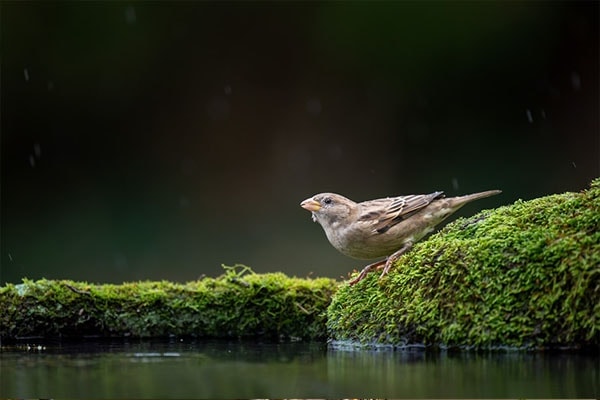
Birdbath fountains are not just simple basins with water. These birdbath fountains have splashing, dribbling, and streaming water to allow for birds to drink and preen.
There are many different types and designs for bird fountains. Some more elaborate than others. It can have a simple stream like a waterfall or some splashing water to allow for easier drinking and preening or grooming.
The design and type of splash of water you have on your fountain also greatly affects how you can attract birds. The more splashing there is the more birds that may come to your fountain. Some birds enjoy the geometric shapes, while some prefer a plain fountain design.
Whatever fountain you choose, make sure that you maintain it well. Here are a few tricks to easily take care of your fountains:
- Keep them away from bird feeders as stray seeds and feeds can clog the fountain.
- Pace it where it wouldn’t be easily bumped or tripped on.
- Drain the water in the fountain way before winter comes.
- Make sure no water remains as to avoid cracks and damage to your fountain. Check the water level daily to keep the pump working.
Identifying Birds: Using Bird Guides (Field Guides)
Attracting birds to your backyard or going on a hike to watch and observe birds is awesome. However, being able to identify your favorite birds is a must. To do that, I suggest that you pick up a good bird field guide and keep a birding journal. These are inexpensive and worth the money. This way you get to recognize the different species of birds, their habits, mating calls, migration patterns, etc.
There are many choices to what bird guide you can use. There are traditional guides such as books and there are guides that are updated that you can check on your phone through certain apps. Once you find a guide for yourself, you can start building your bird book of what you have seen and what you still wish to see.
Traditional Birding Guides
One way to go is to pick up a book on the different types of birds in the country and around the world. There are many books that you can choose to help you identify and locate the birds that you are looking for. Here are some examples:
The Sibley Guide to Birds
- Sibley Guide To Birds, 2nd Ed
- Sibley, David Allen (Author)
- English (Publication Language)
- 624 Pages - 03/11/2014 (Publication Date) - Knopf (Publisher)
The Sibley Guide was released in 2000 and has easily become the standard book guide for birdwatching. Since its release, it has remained the top birding guide that most bird watchers still use up to this date. It has David Sibley’s classic drawings with more plumages and subspecies than any other guide today. There is a 2014 Second Edition Version of this book you can get without the minor printing issues of the original release.
Photo Birding Guides
A long-standing debate between birdwatchers is whether photos or illustrations are best. A photo can depict the bird in its natural habitat state while you can draw the bird into the plumage and position you want with illustrations.
In my opinion, both books below have great depictions of the different bird types and species. While The Stokes Field Guide has more photos, the Kaufman Field Guide is more compact and you can bring in to the field.
- Fantastic field guide for birds found commonly throughout North America
- Includes range maps, color photos, and common behaviors of each bird
- Has informtion on differntiating different bird species, and plenty of identification help
- Special emphasis placed on identifying birds by shape
- Written by preeminient birders Don and Lillian Stokes
- Used Book in Good Condition
- Kaufman, Kenn (Author)
- English (Publication Language)
- 384 Pages - 07/19/2025 (Publication Date) - Houghton Mifflin (Publisher)
Peterson Field Guide to the Birds of North America
Created by Roger Tory Peterson, this classic bird guide is loved by many. He modernized the use of bird guides when he released his Field Guide to the Birds in 1934. It has breathtaking artwork with the use of bright colors. With this book, you will feel the love of birds and birding with Peterson’s book.
He has then released an enlarged version of his book in 2008.
- Peterson Field Guide Birds Na
- Peterson, Roger Tory (Author)
- English (Publication Language)
- 527 Pages - 08/01/2008 (Publication Date) - Houghton Mifflin Harcourt (Publisher)
Mobile Birding Apps
As with all things, technology has changed everything. Nursing with a heavy book is not ideal anymore as you can find everything on your phone today. Not only do they offer actual photos and illustrations, but you can also play the sounds of the birds on the apps themselves.
Here are a few apps that you can download directly on your phone to help you identify the birds you see in the field:
- Audubon Birds Guide: North America
- The Sibley eGuide to Birds
- iBird
- Peterson Birds
Whatever app you choose, you will be able to identify what birds are present in your aviary or the field. Be warned, for some of these apps are not updated and may not contain any resources for identifying rare bird species.
Specialized Birding Guides
If you are a fan of a more specific bird type or species, then maybe specialized bird guides would be the best for you to purchase. Here are some examples of specialized bird guides that you can look for when deep-diving into a specific bird.
- The Warbler Guide
- Sparrows of the US and Canada
- The Shorebird Guide
- Peterson Reference Guide to Gulls of the Americas
- Petrels, Albatrosses, and Storm-Petrels of North America
- Rare Birds of North America
However you like your bird guide, remember to always take note of what birds you have seen. Create a list on your phone or a notebook and take down notes on where you spotted them, in what season, and what they are doing. Who knows, you might be the next big birding guide creator.
Birding Equipment
Binoculars
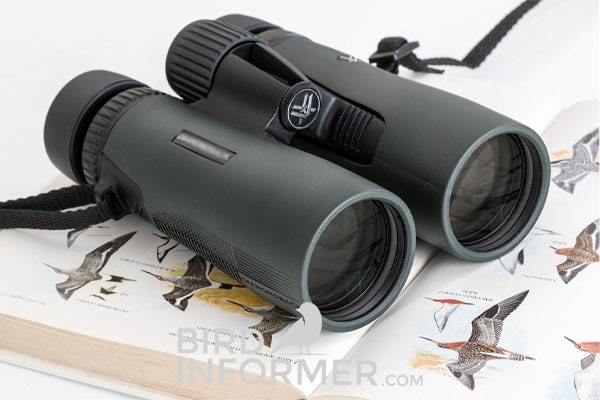
Binoculars are the most essential tool for anyone who loves birdwatching. It is the tool that allows you to observe your target bird from a safe distance without disturbing them. It will give us the sight of these birds when our ordinary eyes fail to allow us to watch them.
The best binoculars do not come cheap. Most birdwatchers like myself have gotten hand-me-downs from the family. However, with new technologies and designs, who wouldn’t be attracted to get themselves the latest versions of their favorite binoculars?
Here are a few tips on how to keep your binoculars in tip-top shape:
- No swinging binoculars – Do not allow your binoculars to swing by the strap on your necks. It is better to get a binocular harness to keep them close to you lest they get damaged while you are birdwatching.
- Tuck in binoculars – When moving along the trail, and performing active maneuvers, always keep your binoculars tucked in to keep them from hitting trees, rocks and other elements in the trail you are on.
- Cover them when in rain – When training, keep them covered to prevent any water to ruin your binoculars.
- Have them professionally cleaned – When water, or freshwater, in particular, gets in your binoculars, hastily get them cleaned by a professional to prevent further damage.
Here are a couple of binoculars that are perfect for you to use while birding:
Leica Camera 40384 Noctivid Binoculars
- Prism Type: Roof
- Magnification: 8X
- Eye relief: 19mm
- Objective lens diameter: 42mm
- Weight: 30.3oz
The Leica Noctivid Binoculars is topnotch in both form and function. It makes use of SCHOTT High Transmission glass with a 12-element lens configuration and their HighLux-System anti-reflection multi-coatings and compact roof prisms to produce bright and high contrast images.
Zeiss Terra ED 8×42 Binoculars
- 88% LIGHT TRANSMISSION - Schmidt-Pechan ED glass with a hydrophobic multi-coating provides optical clarity and precision in all situations.
- COMFORTABLE & FAST FOCUSING - The large and easy-to-grip focus wheel is quick to use on the ZEISS Terra ED binoculars. Your index finger naturally lands on the focusing wheel, always ready when something exciting suddenly happens in front of you.
- COMPACT, LIGHT & ROBUST - With its waterproof, fiberglass reinforced casing, the ZEISS Terra ED satisfies the high standards of nature lovers. Easy to fit into any bag and nearly indestructible, the ZEISS Terra ED is the perfect companion.
- ZEISS ANTI-REFLECTIVE COATING - Guaranteed brilliant, high-contrast images, particularly in adverse light conditions and twilight.
- A CLEAR VIEW IN ANY WEATHER - There are always exciting things to be seen in the world of nature, even in wet weather. ZEISS developed a Hydrophobic Multi-layer Anti Reflective Coating for binoculars and scopes that enables a clear and unhindered view in all weather conditions.
The Zeiss Terra ED 8×42 is a well-balanced HD Binocular that provides outstanding performance. This is mostly used for nature observation with amazing design, ergonomics, and optics. It also comes to you with a very alluring price tag.
Spotting Scopes
While binoculars are essential in a birdwatcher’s kit, Spotting Scopes are far greater in the sense that you can look the bird you are watching in the eye. Spotting scopes have glorious magnification that can help you affirm the bird you have spotted. It takes you closer than binoculars could ever do.
A good spotting scope will change your birding experience. The optics and optical coatings and housing are designed for terrestrial viewing. It means that they are made for you to appreciate nature and its surroundings including the birds you are watching.
Here are a few choices for good spotting scopes you can use to get a closer look on your birds:
Gosky 20-60 X 80 Porro Prism Spotting Scope
- Fully multi-coated 80mm green film objective lens, eyepiece and quality prism inside - guarentee the key elements of a spotting scope, and make your view brighter, clearer and delivers crisp images.
- Variable 20x to 60x magnification and dynamic lens focusing system -- makes it easy to zoom in on target. Designed for birdwatching, watching wildlife and scenery.
- Durable Magnalium Framework and Rubber Armor - Its tight fitting protection makes it usable to withstand the toughest weather conditions. The shock-absorbing rubber armor for maximum protection. And the eyepiece shield can be stretched out to protect the eyepiece.
- Waterproof Design : Its sealing property ensures the living waterproof function.
- Comes with a digiscoping adapter for digiscoping. (Note: for all spotting scopes, the original picture is in a circle, pleae zoom the camera to get a full screen picture.) It also comes with Carrying Case, Eyepiece and Lens Protection Covers, Cleaning Cloth and handy Straps.
This spotting scope is a favorite among many birders. It is specially designed for bird watching and outdoor activities and features the following:
- Fully multi-coated 80mm green film objective lens, eyepiece, and quality prism
- Variable 20x – 60x magnification and dynamic lens focusing system
- Durable magnalium framework and rubber armor
- Waterproof design
- Comes with a digiscoping adapter for digiscoping in the distant world
- Comes with a metal tablet tripod
Landove HD 20-60×80 Spotting Scope
- Big Eyepiece and High Magnification:Variable 20x to 60x magnification and dynamic lens dual focus system -- makes it easy to zoom in onto your target. HD 58mm 2.3inch big eyepiece and 45 degree angled eyepiece ergonomic allows more comfortable and profession.Coaxial coarse and fine focus dials for quickly achieving and clarifying the image.
- BAK4 Prism and Larger Lens:Big 85mm objective lens and fully multi-coated optics with BAK4 Porro Prism and 9pcs/4groups lens increase light transmission, deliver bright, clear, crisp images even in low-light conditions.
- New Design Phone Adapter: Capture and share! Comes with a 2023 New Design Large smartphone digiscoping adapter for taking photos and videos of what you have acquired. You can share the amazing moment with your friends and families,post the pictures and video into facebook or other social network site.Perfect for target shooting, archery, hunting, bird watching, wildlife watching, scenery, astronomical observation, outdoor activities.
- Nitrogen Filled Waterproof and High Quality Built:Nitrogen filled waterproof and fog-proof design enables the scope to withstand the toughest environments. High quality rubber outer layer, non-slip, shockproof and easy to grip, and provides lasting protection. The telescopic sunshade of the objective lens reduces glare and prevents accidental damage to the lens. The spiral-up eyepiece cover adapts to any situation and is unobstructed even when worn with glasses.
- The 85mm green film objective lens allows more light into the scope, plus with XR anti-reflective coatings on exterior surfaces help obtain brighter views in low-light situations. Rotating tripod mount can position the eyepiece up, down or sideway as needed for the most comfortable viewing position. The protection soft cover, eyepiece and lens protection covers make you more convenient to maintain.
This spotting scope has a powerful zoom magnification range from 20X to 60X power, meet your different observation needs. Along with a tabletop tripod, smartphone digiscoping adapter and carrying case, this high power spotting scope not only provides a wide HD optics zoom vision but also brings a steady and comfortable viewing condition. The scope features:
- Variable 20x to 60x focal zoom magnification
- Coaxial dual-speed focusing dials
- Fully multi-coated green film optics
- 80mm large objective lens
- Nitrogen filled and O-ring sealed optics
- Tabletop tripod
- 45 degree angled eyepiece and 180 degrees rotating functions
- Adjustable eyecups
- Specially designed for Bird watching, Wildlife watching, Hunting, Target Shooting, Archery, Outdoor Activities, etc
- Comes with a specially designed phone adapter for this big 2-inch eyepiece
Camera
Cameras are now a big part of who we are as a society. We can easily take a photo of a moment simply at the palm of our hands. In birdwatching, there comes a time where you will move from simply observing the birds to taking momentous photos of the birds that you encounter in the field.
A phone camera can only take so much. For clearer and crisper photos, professional cameras are needed to capture these memories on the field. Here are a couple of cameras that can aid you in possibly completing your birding wish list and identifying the rarest of birds.
Canon Powershot SX70 HS
- Powerful 65x optical zoom
- 203 Megapixel CMOS sensor and DIGIC 8 image processor
- 4K video and 4K time-lapse movie
- 039-Type Approx 236-million dot, OLED EVF
- Use the EOS Utility Webcam Beta Software (Mac and Windows) to turn your compatible Canon camera into a high-quality webcam
This camera is a bridge camera that features a fixed long zoom lens. The SX70 has 65x zoom and an electronic viewfinder. It can easily best some of the better DSLRs in the market today. However, because of the fixed lens, it is not the best option for action shots like when birds start to fly away. They are more suited to capturing photos of birds that are sitting still.
Canon EOS 7D Mark II
- 20.2 MP CMOS sensor and ISO 100-16000
- High speed continuous shooting up to 10.0 fps
- 65-point all cross-type AF system
- Stunning Full HD video with Custom Movie Servo AF (speed and sensitivity)
- Dual Pixel CMOS AF enables you to shoot video like a camcorder
The EOS 7D Mark II is a big favorite among birdwatchers. It has amazing functionality that gives other cameras a run for their money. It has dual DIGIC processors delivering continuous shooting of more than 1,000 JPEG images and 31 RAW photos. If you have erratic birds flying in the distance, fear not, because the phase detection on this camera allows you to shoot them with ease.
Birding Destinations
Birdwatching or Birding will take you places. To see a multitude of birds, you will need to leave your comfort zone and try various places to find rare birds that are only native to a specific area. Here is a list of the best destinations for birdwatching in the US and Canada with additional destinations outside of North America:
US and Canada
Southeastern Arizona
The corner of southeastern Arizona is a hotspot for birdwatchers everywhere. It has a total of 24 hotspots where these birdwatchers observe, take photos and enjoy the birdlife around Arizona. Click here for more information.
Best time to visit: April through September
Birds Sighted: Elegant Trogon, Painted Redstart, Gray Hawk, Mexican Jay, a dozen hummingbird species
Cape May, New Jersey
Birding in Cape May, New Jersey is a feast! Aside from the number of birds to be seen, it also holds the most number of events for birdwatching. Events such as the World Series of Birding, Cape May Spring Weekend, Cape May Fall Weekend, the hawk watch are what people go to Cape may for. Click here for more information.
Best time to visit: September and October for raptor migration, May and early June for shorebirds
Birds Sighted: Hawks, warblers, shorebirds, waterfowl, swallows, wrens, sparrows, and buntings
J.N. “Ding” Darling National Wildlife Refuge, Florida
The Wildlife Refuge in Darling, Florida is famous for the numerous wading birds that can be spotted there. The vas freshwater habitats, mangrove forests, and mudflats attract almost 300 species of birds. Click here for more information.
Best time to visit: December through April
Birds Sighted: Mangrove Cuckoo, Roseate Spoonbill, Wood Stork, White Ibis, plus ducks in winter, and songbirds in spring
Point Reyes National Seashore, California
The Point Reyes Peninsula and the surrounding 70,000-acre Point Reyes National Seashore attract a multitude of types of birdlife. More than 460 species of birds have been spotted and recorded as of this day. Click here for more information.
Best time to visit: Spring and fall migrations are what’s most awaited
Birds Sighted: Seabirds, shorebirds, warblers, woodpeckers — you name it, it’s probably at Point Reyes
Point Pelee National Park, Ontario
One of Canada’s most popular and most visited parks, the Point Pelee National Park is where migrating birds in the Atlantic and Mississippi airways take refuge after a long flight. It is one of the most important bird areas globally because of its freshwater marshes, sandy beaches, and cedar savanna. Click here for more information.
Best time to visit: May and the fall season
Birds Sighted: 36 warbler species are sighted annually
Corkscrew Swamp Sanctuary, Florida
The Corkscrew Swamp Sanctuary protects the country’s largest remaining stand of virgin bald cypress and has a two-mile boardwalk that lures birdwatchers from far and wide. Click here for more information.
Best time to visit: All year round, but Nesting Seasons are March and April
Birds Sighted: Wood Stork, Swallow-tailed Kite, Red-shouldered Hawk, songbirds, and waders.
Everglades National Park, Florida
The Everglades, although facing numerous developments over the decades, it remains to be a mecca for birdwatchers everywhere. It became a national park because they wanted to protect the birds that were wading and making the everglades home to more than 400 species of birds. Click here for more information.
Best time to visit: December through April
Birds Sighted: Limpkin, Snail Kite, Short-tailed Hawk, Mangrove Cuckoo, Greater Flamingo
Global Destinations
Isle of May, SCOTLAND
The Isle of May in Scotland is home to 120,000 Puffins from April to Mid-August. It is a haven for numerous other birds but the main attractions are the Puffins the fill the Isle. Watch as they duck dive and plunge into the deep waters below. Click here for more information.
Playa Larga, CUBA
Because of the swampy grasslands, mangrove forests, and coral reefs, the Cienaga De Zapata National Park in Playa Larga, Cuba is a haven for many birds. It is home to 28 species of birds that can only be seen in Cuba. A place to put in your travel list. Click here for more information.
Ngorongoro Crater, TANZANIA
Safari in Tanzania is one of the best places to do some birding. Hundreds of bird species call this their homes like the African Bustard, Kite Birds, ostriches, and many more. Click here for more information.
Jardin, COLOMBIA
Pay your way to enter the private reserve where you can see hundreds of bird species and some only native to Colombia. The Andean Cock is one of the main attractions of this private reserve. Enter the wonderful world of birding in Reserva Natural de Rocas in Colombia. Click here for more information.
Bocas Del Toro, PANAMÁ
Isla Bastimentos National Marine Park can be found in the beautiful Bocas del Toro in Panama. This archipelago has recorded over 1,000 species of birds for as long as they’ve known. A place like this is a mecca for birdwatchers. Click here for more information.
Ranganathittu, INDIA
The sanctuary in Ranganathittu is a small archipelago in the Cauvery River basin. Many birds use this basin as a nesting ground, Pelicans and Storks among some of them. Take a boat ride to get the full experience of bird watching in India. Click here for more information.
Other Birdwatching Resources
If you do not enjoy birdwatching alone, or you want to find a new friend that you want to share the passion of birdwatching with, there are some clubs and groups on the Internet and on Facebook that you can join to completely enjoy birdwatching. Here are some of them:
- The New York City Audubon
- American Birding Association
- Facebook Birders
- American Birding Association (Facebook)
- MD Birding (Facebook)
Amazon Best Rated Products - Last Updated on 2025-07-18. DISCLAIMER: Some or all of the product links on this page are affiliate links. The operator of this website received a small commission if you purchase products through these links, HOWEVER, there is no added cost to you. These commissions help to fund the operation of this BirdInformer.com

